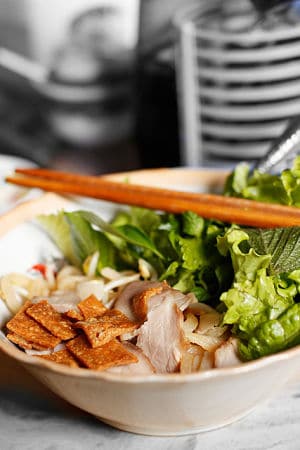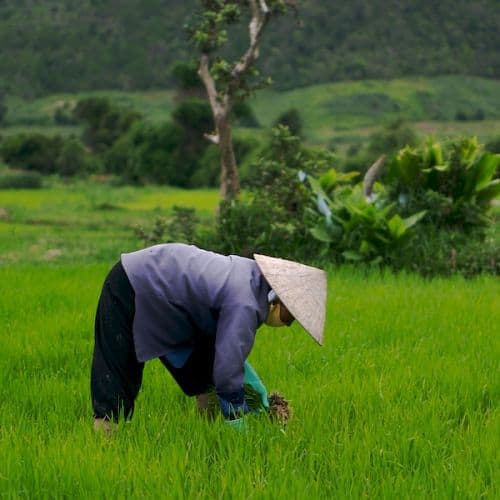In his book Rice Talks: Food and Community in a Vietnamese Town, anthropologist Nir Avieli brings to light the importance of understanding the historical and socio-cultural elements that dictate food and consumption in society. Using his dissertation research from 1999 based in the town of Hoi An, Avieli discusses the greater cultural and social processes that underlie the preparation and consumption of food in Vietnam. Composed of seven chapters, Avieli’s ethnographic account and analysis illustrates how social order and cultural constructions are reproduced in the Hoianese meal.
Using Don Handelman’s (1998) paradigm on public rituals that consists of model, mirrors, and representations, Avieli argues that gender, social status, ethnicity, and religious cosmology are revealed and reconstructed within the Hoianese culinary sphere where food and consumption are involved in an intricate process of cultural production, reproduction, and negotiation (p. 15).

Avieli’s introduction begins with the historical contexts surrounding the town of Hoi An and follows with the analytical lens he used during his field research in Vietnam. In Chapter 1, Avieli outlines the basic dyadic structure of the Hoianese meal that consists of rice and “things to eat”, which further develops into a “twofold-turned-fivefold” structure consisting of five levels of transformation of edible ingredients into food (p. 19). Avieli analyses the cultural elements involved in nutritional logic and the cosmological symbolism found within the structure of the meal. Chapter 2 focuses on the social dynamics of gender and space in the preparation of food inside the Hoianese home. Avieli discusses the preparation stages of a meal: the symbolism in presentation and aesthetics such as the colours and textures of the dishes served in harmonious “complementary oppositions” (p. 54), and the patterns of consumption dealing with gender and age. Stepping out into the streets, Chapter 3 discusses the cultural and historical elements that construct Hoi An identities through local food specialities. The chapter explores why certain dishes are consumed on a daily basis more than others, such as cao lau and banh bao bahn, which carry the existence of various representations of Hoianese identity.
Chapters 4 through 6 examine the communal rituals of Hoianese society, and the important role that food plays within them. Beginning with Chapter 4, Avieli discusses ancestral rituals such as the mortuary rite of dam gio. While the function of these rituals are to assist the deceased in the afterlife, the preparation and consumption of food in these rites also represent a social interaction between the deceased and the living. Avieli argues that these rituals are not specific life-cycle events, but rather family-cycle events oriented towards the family unit as a whole, encompassing more than one generation of family members (p. 101-102). Wedding feasts, as described in Chapter 5, are the single most important event in Hoianese lives. Lasting for several days, the preparation and consumption of food plays an important role in each ritual stage of the marriage ceremony. Avieli provides a chronology of the stages present in a Hoianese wedding and separates each stage to discuss the different social contexts that exist within the accompanied traditional feasts.
 Chapter 6 delves into the family as a social unit, and expands the discussion of food and ritual in the context of community festivals. Focusing on different communal meals present in Hoianese society, Avieli discusses clan ancestor worship, Protestant holiday celebrations, and annual communal feasts that take place throughout the year. While the eating arrangements for community festivals are similar to the family-oriented style of preparation and consumption, prepared food served at communal festivals features diverse, specific sets of dishes distinguishing each communal meal from other festival foods (p. 173). Community festivals, such as clan feasts, serve as a way to create familiarity and closeness among people who participate in these celebrations. In Chapter 7, Avieli discusses the food served at the three most prominent festivals in Hoi An: Tet Nguyen Dan (Vietnamese New Year), Tet Doan Ngo (Summer Festival), and Tet Trung Thu (Mid-Autumn Festival), and examines the culinary symbolism existing within the special dishes prepared and consumed during these celebrations. Avieli wraps up his discussion on food and consumption in Hoi An with a brief conclusion and reflection on his research that discusses the challenges of conducting fieldwork as an outsider of the Hoi An community.
Chapter 6 delves into the family as a social unit, and expands the discussion of food and ritual in the context of community festivals. Focusing on different communal meals present in Hoianese society, Avieli discusses clan ancestor worship, Protestant holiday celebrations, and annual communal feasts that take place throughout the year. While the eating arrangements for community festivals are similar to the family-oriented style of preparation and consumption, prepared food served at communal festivals features diverse, specific sets of dishes distinguishing each communal meal from other festival foods (p. 173). Community festivals, such as clan feasts, serve as a way to create familiarity and closeness among people who participate in these celebrations. In Chapter 7, Avieli discusses the food served at the three most prominent festivals in Hoi An: Tet Nguyen Dan (Vietnamese New Year), Tet Doan Ngo (Summer Festival), and Tet Trung Thu (Mid-Autumn Festival), and examines the culinary symbolism existing within the special dishes prepared and consumed during these celebrations. Avieli wraps up his discussion on food and consumption in Hoi An with a brief conclusion and reflection on his research that discusses the challenges of conducting fieldwork as an outsider of the Hoi An community.
Rice Talks: Food and Community in a Vietnamese Town is an excellent introduction to the complexities underlying the study of food and culture within Southeast Asian societies.
Each chapter is full of vivid descriptions of food preparation, taste, and consumption interwoven into the cultural fabric of the Hoianese culinary sphere. Avieli focuses on the importance of nutrition, consumption, and cultural practices in Hoi An through a combination of analysis and personal accounts. For students, researchers, or everyday readers looking to explore the area of nutritional anthropology, Avieli provides a wonderfully written ethnographic narrative that is as engaging as it is appetizing.
Avieli, Nir. 2012. Rice Talks: Food and Community in a Vietnamese Town. Bloomington: Indiana University Press. 336 pp. Pb: £15.99. ISBN: 9780253223708



